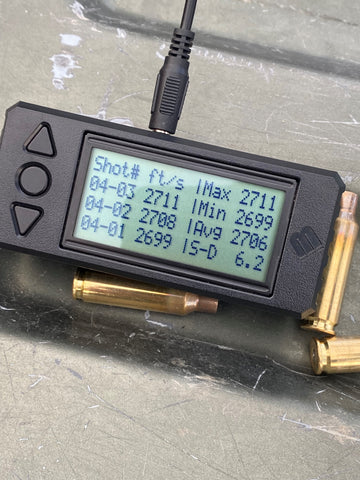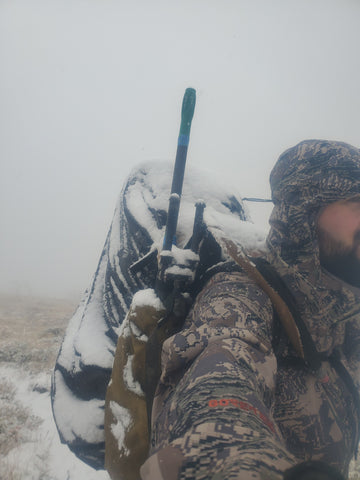The target is lined up in your sight. You've made similar shots many, many times before. However, the early morning air is bitterly cold in this new environment as your gloved finger slowly pulls the trigger. Will you hit your target, or will cold weather affect you and your gear in unexpected ways?
Failure could result in a lower score, a missed animal, or worse. The reasons for failure also vary but can be categorized broadly as either human or mechanical—in other words, cold temperature affecting the rifle itself or the operator.
Chilling Effects: The Science Behind It
Internal and external ballistics are affected in cold environments, so you'll need to account for the changes below to maintain peak accuracy.

- Muzzle Velocity: Lower temperatures result in lower muzzle velocity and higher air density, which affects the bullet's trajectory.
- Thermal Contraction and Expansion: Heat causes metal to expand, while cold causes it to contract. Metal rifle barrels can contract ever so slightly, although any such effect becomes even less noticeable after firing a few rounds.
- Condensation: Also known as sweating, condensation forms when moving firearms from colder to warmer locations. This moisture can freeze when the firearm is again exposed to cold.
Battling the Elements: Shooter's Challenges
The winter months affect people in negative ways that can affect their accuracy. The fingers are particularly vulnerable to the cold, resulting in stiffness, tremors, and reduced dexterity.
Wearing gloves can help retain warmth but also introduce other problems, such as reduced sensitivity and added bulk. As such, low temperatures can affect your ability to operate the trigger properly, with or without gloves.
Similarly, a thick winter coat affects your rifle fitment, specifically the length of pull and eye relief of any given scope. The rifle's length of pull should be adjusted accordingly while wearing the type of clothes expected on an upcoming hunting trip.
Hot Shots: Choosing the Right Gear for Flawless Winter Precision
The vast majority of issues caused when the temperatures drop near or below freezing can be remedied to varying degrees with appropriate gear. Some can be eliminated entirely.
- Ammunition: All modern rifle ammunition copes well with extreme cold and heat, although fluctuations in temperature still causes problems. For hand loaders, look for a powder that is less temperature sensitive like the Hodgdon Extreme line.
- Gloves: It's important to strike a balance between thickness (warmth) and tactile sensitivity. This can be achieved with purpose-made gloves made from Thinsulate or other synthetic fiber. Shooters can also purchase gloves made for shooting which allows them to expose their trigger finger when they are ready to take a shot.
- Mats: A good shooting mat is a great for anyone concerned with rifle accuracy while firing from a prone position in wet and cold environments. A shooting mat will also help keep any dirt or snow away from the rifle.
- Rifle Support: In cold weather, snow is commonly involved. Practicing off different gear for elevated shots to stay out of the snow can be the difference between executing a precision shot and not. Items like tall bipods, tripods, backpacks, shooting sticks, or trekking poles can all be incredibly stable and useful tools.
- Rifle/Optic Protection: Mother nature can be brutal. As hunters and avid marksmen, we take the time to equip ourselves with the appropriate apparel and gear for what she throws at us. Why not your rifle and optic? There are a multitude of scopes, scope & action, and complete rifle covers to help protect these parts from moisture, debris, and even unintended impacts while in the field. Some offer more protection than others, while some are designed for weight savings and other options for durability. Choose something that suits your needs to keep your precision rifle in tip-top shape.

Gear Up for Precision: XLR Industries Chassis Systems & Accessories
The XLR Advantage: For those seeking ultimate accuracy, consider an XLR Industries Chassis System. These premium chassis are crafted from high-grade aluminum and magnesium alloys specifically chosen for their thermal stability. This means minimal forend flexing and POI (point of impact) shift, even in the harshest environments.
Our selection of premium tactical and hunting chassis systems has what you need to keep the weight down with superior thermal stability; XLR rifle chassis materials are game-changers in frigid temperatures.

Taming the Tundra: Practical Strategies for Accuracy
- Making Adjustments: Accuracy can be improved by making small adjustments to the rifle's length of pull. This will correct any fitment or eye relief issues commonly seen when shooters add a heavy jacket.
- Breath Timing: Exhaling just before firing is commonplace for many shooters. In colder air, however, the moisture from your breath could freeze in contact with the lens or other parts of your scope, rendering it useless.
- Acclimatization: Regardless of clothing and preparation, you can't simply exit your toasty warm vehicle and immediately expect to perform well in the cold air. Take time to adapt, and test your progress over the course of time.
- Storage and Maintenance: Rifles and modern ammunition can be stored without serious cold weather deterioration in even the harshest naturally occurring lows, although extreme heat causes a risk for ammo storage. Temperature sensitivity becomes an issue as temperatures change so test your ammunition in the conditions you will be shooting in. Maintenance should include firearm-specific lubrication rated for expected temperatures.
From the Field: Case Studies and Expert Insights
As explained in detail by the Guns & Ammo editorial staff, cold temperatures have a negligible effect on ballistics at distances under 500 yards (~460 meters). Generally, no adjustment is necessary for shooting sub 500 yards. This guide gives advice on how to improve rifle accuracy at far greater distances.
The U.S. Armed Forces regularly performs cold-weather testing of shoulder-fired weapons. Test procedures regarding rifle and ammunitionstorage, accuracy, reliability and durability are publicly available. These reports help you identify safety and human factors to account for, such as winter clothing types.
Keeping Your Cool, One Shot at a Time
The mechanical issues associated with long-range shooting and accuracy in the cold are relatively simple to overcome with proper storage, maintenance, practice and dedication. You can account for the difference in load and trajectory and overcome human factors with the right gear.
If at first you don't succeed in your winter expeditions, don't worry. You're not alone. Even our best and bravest can struggle to cope with cold weather training. The only path forward is to try, try again.
Check our blog for valuable resources on cold-weather shooting tips and gear recommendations specific to XLR high-performance chassis systems.
